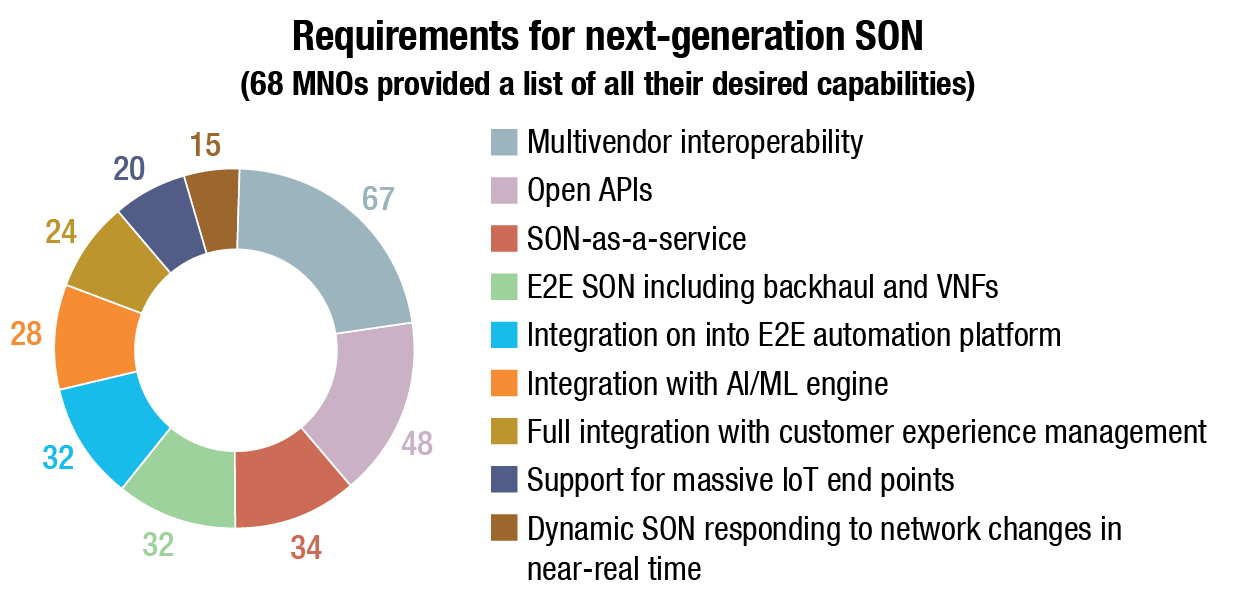5G Features
Small cell SON and orchestration from 4G To 5G

Ambitions for 5G include being both more sophisticated and deployed at scale in enterprise and industry verticals. This points to the need for pervasive end-to-end automation to ensure network operation remains feasible and affordable.
A heavy dose of automation is a key goal for most operators deploying next generation networks. The more they extend their 4G and 5G networks with dense hot zones of capacity, or deep indoors, the more cells they will roll out. These numbers will become impractical to manage and optimise manually, especially with rising customer demands for high quality connectivity and even critical communications.
Supporting many of the services envisaged for 5G, from massive numbers of IoT devices to immersive user experiences, will require near-real time adjustment of the network to ensure the best connection at all times.
Full end-to-end automation remains a relatively distant goal for many MNOs, but there are important steps towards that end point, and Small Cell Forum is engaged in making those steps clear and deployable for operators of all kinds.
The small-cell industry has, through necessity, pioneered the deployment of plug-and-play network equipment. It now has over a decade of real-world commercial experience, which can be leveraged to accelerate the rollout of self-driving 5G networks. Small Cell Forum (SCF) has an extensive body of expertise in developing frameworks for several key aspects of automation, such as management, SON (self-organizing networks), API, and orchestration.
In the 5G era, all of these will increase in importance because of the larger number of cells involved in many networks. They will also become more sophisticated, thanks to the addition of emerging techniques such as the application of artificial intelligence and machine learning to centralized orchestration and management.
SON provides a strong framework to extend automation beyond the radio access network (RAN) to the entire virtualized small-cell network in future. SON is the automated configuration of RAN, and has always been essential to small cells’ plug-and-play and large-scale deployment model. SON has been commercially deployed for over a decade, and its functions are natively standardized in 4G LTE.
SCF has developed SON-related API and hosted SON-themed plugfest interoperability testing events.
There is a definite need for open and interoperable interfaces to enable broad end-to-end automation across networks, built with equipment and software from many suppliers.
Mobile operators have top three priorities for next-generation SON – multivendor interoperability, open APIs, and SON-as-a-service.
With this in mind, it is essential that there are open and interoperable interfaces to ensure that any network resource can be added to the mix without the need to reprogram the whole system.
Management, in this context, the way network equipment is monitored and configured, is arguably the most important enabler for end-to-end automation. Management models are being rewritten for 5G for a number of reasons:
- the need to exist in a virtualized environment with COTS hardware;
- the aim to effect commonality of management frameworks for a large variety of network elements including small cell components; and
- because legacy approaches could not provide data at the kind of refresh rate needed for these more sophisticated and dynamic types of automation.
An example is the O-RAN Alliance’s management models, albeit these are being developed mainly for macrocells and also assuming significant data volumes per cell. The scale of small-cell deployments requires leaner models so that the management traffic can remain a small overhead in the network.
Market analysis
The migration to 5G architectures, including virtualized and disaggregated networks, will be a key driver for automation. A survey of 68 MNOs conducted by Small Cell Forum in 4Q2019 shows that virtualization will be the most common driver for operators to introduce automation technologies such as SON to their small-cell networks. However, there is also concern with adding higher levels of automation to existing traditional networks and to make them more efficient, particularly as operators extend or densify them. The MNOs could introduce new automation measures for a new virtualized network, or plan to do this for an existing physical network.
The changes inherent in 5G-era networks will drive accelerating investment in new SON capabilities, and the technology is expected to be greatly expanded in its reach and remit in the early 2020s.
Open, multivendor SON, with the resulting flexibility and cost-effectiveness, leads the way in terms of next-generation requirements.
Adoption of these new technologies could greatly increase the number of network processes that are automated, and that in turn will drive the scale of small-cell deployment by making it simpler and more affordable. There exists an opportunity to accelerate at-scale densification that should not be missed.
Recommendations
 The number of use cases will greatly expand in the 5G era. Another important element of 5G is the diversity of spectrum bands, and the way those bands can be used to support many types of deployers. The existence of highly disparate frequency bands, each with their unique propagation characteristics, will require a diverse set of tools for capacity and coverage planning. In some cases, as seen in the USA’s CBRS band, a spectrum-access system may perform some of the roles of SON.
The number of use cases will greatly expand in the 5G era. Another important element of 5G is the diversity of spectrum bands, and the way those bands can be used to support many types of deployers. The existence of highly disparate frequency bands, each with their unique propagation characteristics, will require a diverse set of tools for capacity and coverage planning. In some cases, as seen in the USA’s CBRS band, a spectrum-access system may perform some of the roles of SON.
Openness
It is important that the industry supports open interfaces in SON and MANO to allow operators the flexibility to adopt solutions from different vendors, as well as moving toward a common management approach for all equipment in the end-to-end network.
From SON to open MANO
 In the small-cell world, SON has been an important step toward the vision of full service-level automation, along with DevOps-style processes for planning and deploying networks and services. In order to manage hyperdense and heterogeneous small-cell networks, traditional SON will need to be enhanced with advanced algorithms, which make it more dynamic and which extend its reach beyond the access network to cover core, backhaul, and IT assets. It will eventually leverage machine learning and artificial-intelligence techniques to evolve beyond just automating the optimization of the network, and to add a hefty dose of intelligence to those automated decisions. In this context, a gradual movement from native SON/RRM to RIC architecture is likely. The transition will be filled with challenges, such as conflict between native and third-party solutions and parameter matching.
In the small-cell world, SON has been an important step toward the vision of full service-level automation, along with DevOps-style processes for planning and deploying networks and services. In order to manage hyperdense and heterogeneous small-cell networks, traditional SON will need to be enhanced with advanced algorithms, which make it more dynamic and which extend its reach beyond the access network to cover core, backhaul, and IT assets. It will eventually leverage machine learning and artificial-intelligence techniques to evolve beyond just automating the optimization of the network, and to add a hefty dose of intelligence to those automated decisions. In this context, a gradual movement from native SON/RRM to RIC architecture is likely. The transition will be filled with challenges, such as conflict between native and third-party solutions and parameter matching.
The industry needs to come together to smooth this transition, if the RIC architecture is to succeed. In the 5G era, not only will multivendor interoperability between any of the elements be crucial, so too will multi-radio networks (cellular, Wi-Fi, and shared spectrum). Furthermore, as the networks become virtualized, orchestration by a single framework that also includes business-level policies will be critical.
SCF members identified the following success factors for virtualized networks:
- Open interoperability among different orchestrators, and among all the components of the virtualized or hybrid HetNet;
- Future-proofing, so that a 4G deployment can be combined or migrated to 5G within the same orchestration environment – as well as the ability to integrate legacy and physical systems efficiently;
- Firmer proof of compelling use cases and business cases, which require the new orchestrated HetNets; and
- Open development platforms to encourage an ecosystem of applications and services that take advantage of the new platforms.
Other key requirements will be enabled or bolstered by an open orchestration framework, including ease of interworking between small cells and the macro network, virtualization of the HetNet, full automation, and migration to 5G.
With regard to interoperability, several industry organizations are working on common interfaces but the two most prominent candidates to provide the single orchestration framework are two key SCF partners – ETSI with its open source MANO (OSM) industry specifications group (ISG), and ONAP (open network automation protocol) – whose MANO platform is based on the code developed by operators.
Both these initiatives are working toward the definition of open architectures for control, management, and orchestration of complex virtual and virtual/physical HetNets.
While there is large amount of consistency between the two, ONAP also addresses policy aspects.
Courtesy: Small Cell Forum.















You must be logged in to post a comment Login